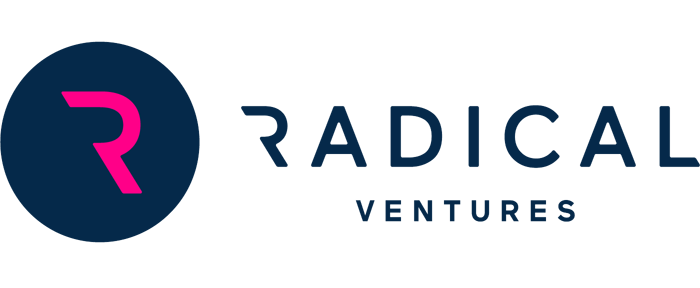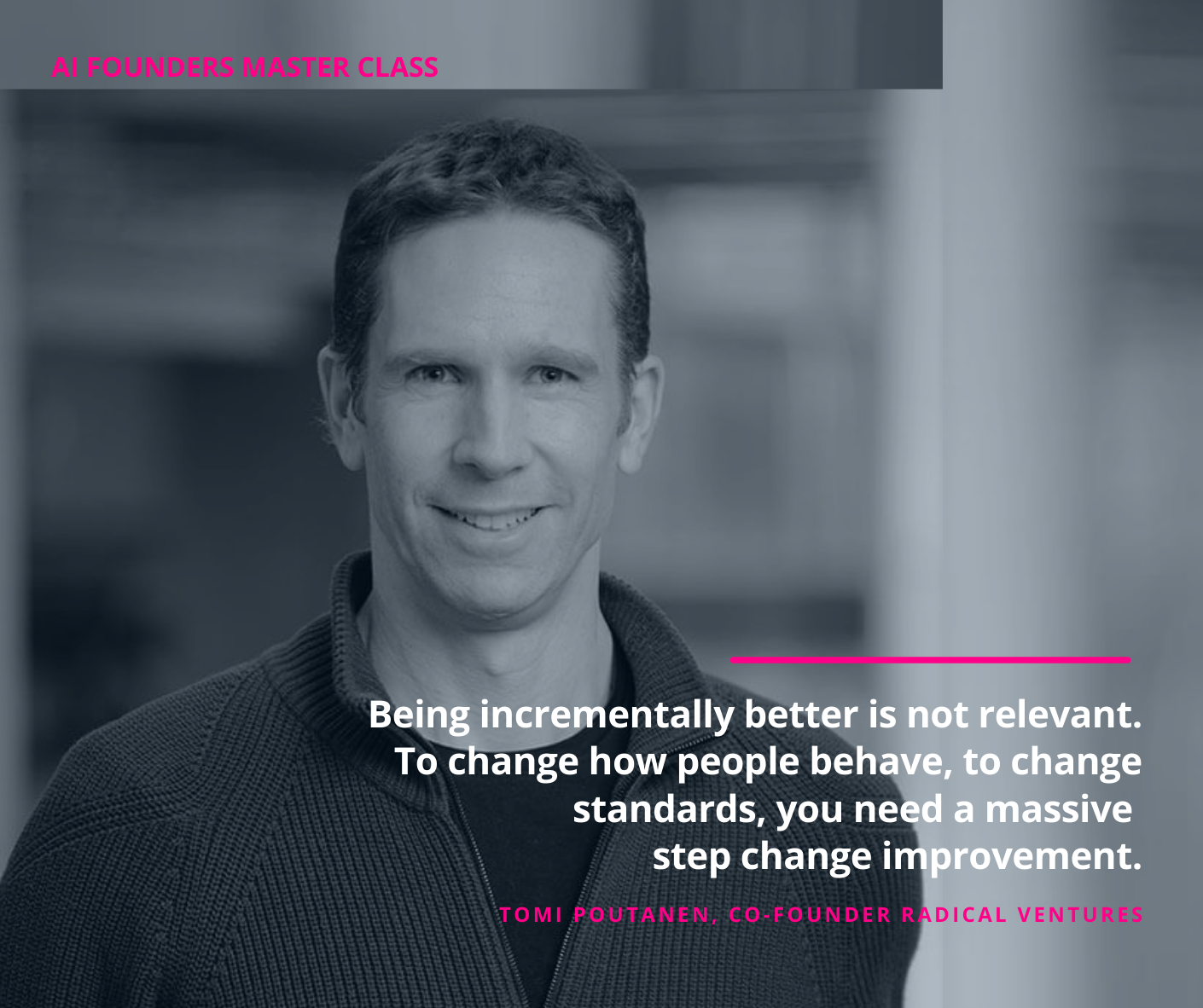The path from AI research breakthrough to commercial success is frequently charted by product development and innovation. Building scalable products around the needs of the customer can be a key factor in a company’s growth trajectory. Tomi Poutanen has built AI products and scaled product teams over the past 20 years as an entrepreneur and founder of five companies with exits to Microsoft, Yahoo! and TD Bank. Today, Tomi is a Co-Founder and Partner at Radical Ventures and is currently working to bring AI to healthcare with the new startup, Signal 1.
Tomi’s journey from engineer to entrepreneur and reflections on the mindset required to build and sell products at scale was captured as part of Radical Ventures’ AI Founders Master Class – a four week program aimed at helping AI researchers build AI products and businesses. The following excerpt of his presentation has been edited for length and clarity.
I started my first venture when I was an undergraduate at The University of Waterloo. I built a data compression software product. I had a lot of people sending me twenty dollar cheques for the premium features. It funded my tuition, but I took building a product seriously. I had a co-founder and our product was better than the competition by about 10%.
But, I learned that being incrementally better is not relevant when you are trying to build a business. To change how people behave, to change standards, you need a massive step change improvement. I believed there was a lot of value to be created. I knew I had something unique. But, I had to pivot from competing against the established standard to thinking about creating new value.
This was back in 1995. Software distribution is where data compression really mattered. Microsoft was shipping more software and floppy disks than anyone else in the world. Windows 95 had just come out and was shipped on 13 floppy disks for installation. Microsoft was spending a lot of money on these disks (about US$1 per disk). That 10% compression ability meant we could take Windows 95 from 13 to 11 floppy disks. Although that doesn’t sound like a lot, it was an innovation worth $100 million to Microsoft. So, what do you do as an undergraduate student? I got a co-op job at Microsoft and self-selected the Windows SDK team, got to know the team whose task it was to package up the operating system, and had a value proposition to save the company $100 million on day one.
That set me off on a lifelong journey trying to do innovative things through having a technical edge. It is about how you turn an “aha!” moment into a business. There are very few moments where you have some idea that completely changes things. I have had four in my life and I could express each of them in 50 lines of code. Out of all of the code I have written in my life, there are 200 lines that have really mattered and there are another 200,000 lines that anyone else could have done. But out of those 200 lines of code there was some unique innovation in there that made things possible.
Innovations can have a great impact in enabling new ways of doing things that can stand the test of time. I sold that first data compression innovation 25 years ago and Microsoft still uses the very same compression algorithm today for Azure Cloud storage and online software distributions.
The AI Founders Master Class will return in the fall with more inspiration and insights for prospective founders of AI businesses.
AI News This Week
-
Canadian federal government reveals plans for $443 million second phase of Pan-Canadian AI Strategy (BetaKit)
In 2017, the Government of Canada awarded $125 million in initial investments to create and implement phase one of the Pan-Canadian Artificial Intelligence Strategy, the world’s first national strategy. Radical Ventures Co-founders Jordan Jacobs and Tomi Poutanen are co-author of this strategy — the first of its kind globally. The second phase of the strategy was announced last week, committing more than US$340 million in federal support over ten years to several partners including CIFAR (where Jordan is a director) and Canada’s three National AI Institutes — Amii in Edmonton, Mila in Montreal, and the Vector Institute in Toronto (the latter was co-founded by Jordan and Tomi along with Geoffrey Hinton and other professors, plus Radical Ventures partner Ed Clark, who remains Vector’s board of directors chairperson). The strategy will focus on talent recruitment and retention of AI talent in Canada, advancing AI for health and energy, and new programming to accelerate commercialization, research computation power, and policy on AI’s societal implications.
-
How AI could help predict—and avoid—sports injuries, boost performance (The Wall Street Journal)
AI is increasingly being applied to help athletes improve their performance and avoid injuries. The wearable sensors widely used in athletics today are becoming obsolete as computer-vision technologies, similar to those used in facial-recognition systems at airport customs, enable contactless monitoring. The technology could identify an athlete’s risk of injury based on overuse in real-time, allowing coaches to remove the athlete before the damage happens. Sports such as golf, figure skating, and soccer have already started experimenting with the technology.
-
We taught an AI to impersonate Shakespeare and Oscar Wilde – here’s what it revealed about sentience (The Conversation)
A recent breakthrough in AI is the introduction of language processing technologies that enable us to build more intelligent systems with a richer understanding of language than ever before. Researchers and enthusiasts have used this technology to achieve amazing feats in text summarization, chatbots, search, and code generation. Others have used these capabilities for amusing and creative projects. Recently, researchers at the University of Oxford taught an AI system to impersonate authors as part of a debate on whether “most of the world’s content will soon be created by AI.” Last year, the New York Times used Cohere, a Radical Ventures portfolio company, to determine which version of the famous ‘to be or not to be’ speech in Hamlet (there are many variations due to adaptations, typos, and copycats) was most likely authored by Shakespeare.
-
444 authors from 132 institutions release BIG-bench: A 204-task ‘extremely difficult and diverse’ benchmark for large language models (Synced)
Researchers at 132 institutions worldwide introduced the Beyond the Imitation Game benchmark (BIG-bench), which includes tasks where humans perform well, and current state-of-the-art models are lacking. No model, regardless of size, outperformed the best-performing human on any task. However, the best-performing model beat the average human for some specific tasks, such as answering multiple-choice questions about Hindu mythology. The creators argue that other benchmarks focus on narrow skills. BIG-bench’s diverse, few-shot tasks give researchers new ways to track emergent capabilities in increasingly large language models. Collaboratively developed on the GitHub repository, the BIG-bench project’s code is now open-sourced. The paper Beyond the Imitation Game: Quantifying and Extrapolating the Capabilities of Language Models is on arXiv.
-
France’s Engie use AI to accelerate wind power (BNN Bloomberg)
Even though the cost of wind energy has decreased dramatically in the past several decades, wind projects must be able to compete economically with the lowest-cost source of electricity, and some locations may not be windy enough to be cost-competitive. French utility Engie SA will begin using an experimental AI software technology to predict wind power output thirty-six hours in advance. The forecasts will inform users’ decisions about buying and selling in energy markets. High-accuracy and localized forecasting is a growing category. Radical Ventures portfolio company ClimateAi developed an AI platform uniquely able to predict weather and climate from 2 weeks to 10+ years in the future. These predictions are made at a localized level. They are giving an advantage to businesses that are better informed for their response and adaptations based on weather changes and long-term climate shifts.
Radical Reads is edited by Ebin Tomy (Analyst, Radical Ventures)

